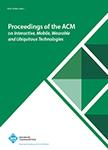版权所有:内蒙古大学图书馆 技术提供:维普资讯• 智图
内蒙古自治区呼和浩特市赛罕区大学西街235号 邮编: 010021

作者机构:Beijing National Research Center for Information Science and Technology Department of Electronic Engineering Tsinghua University China Department of Computer Science Virginia Tech. United States Department of Computer Science Stanford University United States Department of Computer Science and Engineering University of Helsinki Finland
出 版 物:《Proceedings of the ACM on Interactive, Mobile, Wearable and Ubiquitous Technologies》 (Proc. ACM Interact. Mob. Wearable Ubiquitous Technol.)
年 卷 期:2019年第3卷第1期
页 面:1–23页
核心收录:
基 金:This work was supported in part by The National Key Research and Development Program of China under grant 2017YFE0112300 the National Nature Science Foundation of China under 61861136003 61621091 and 61673237 Beijing National Research Center for Information Science and Technology under 20031887521 and research fund of Tsinghua University - Tencent Joint Laboratory for Internet Innovation Technology
摘 要:With the wide adoption of mobile devices, it becomes increasingly important to understand how users use mobile apps. Knowing when and where certain apps are used is instrumental for app developers to improve app usability and for Internet service providers (ISPs) to optimize their network services. However, modeling spatio-temporal patterns of app usage has been a challenging problem due to the complicated usage behavior and the very limited personal data. In this paper, we propose a Bayesian mixture model to capture when, where and what apps are used and predict future app usage. To solve the challenge of data sparsity, we apply a hierarchical Dirichlet process to leverage the shared spatio-temporal patterns to accurately model users with insufficient data. We then evaluate our model using a large dataset of app usage traces involving 1.7 million users over 3503 apps. Our analysis shows a clear correlation between the user s location and the apps being used. Extensive evaluations show that our model can accurately predict users future locations and app usage, outperforming the state-of-the-art algorithms by 11.7% and 11.1%, respectively. In addition, our model can be used to synthesize app usage traces that do not leak user privacy while preserving the key data statistical properties. © 2019 Association for Computing Machinery.